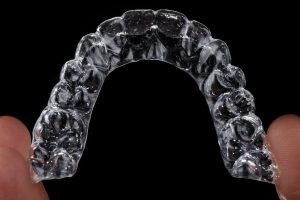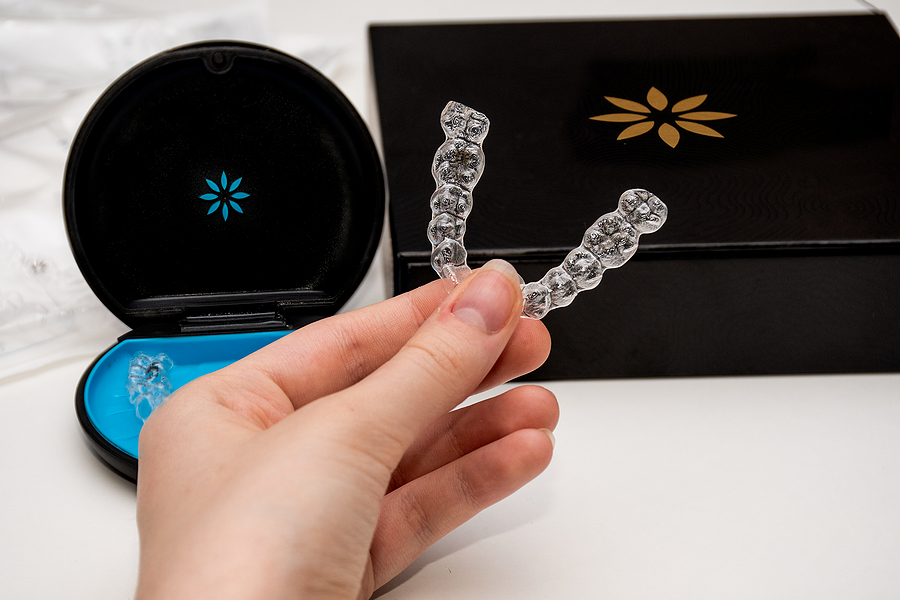Nighttime-only Invisalign sounds appealing for anyone who doesn’t want to wear aligners all day. You put them in after dinner, sleep through the night, and still get straighter teeth—at least, that’s the idea. But does it actually work? And more importantly, is it effective enough to be worth it?
Take a closer look at how nighttime-only Invisalign works, who it’s meant for, and what patients should consider before choosing this limited-wear option.
What Is Nighttime-Only Invisalign?

Nighttime-only Invisalign in Puyallup refers to a clear aligner treatment plan that limits wear time to only 8 to 10 hours per day, usually while sleeping. Instead of wearing aligners all day like traditional Invisalign, this approach focuses on night use only. It’s designed for people who prefer not to deal with aligners during work, school, or social events.
However, the name can be misleading. Invisalign itself doesn’t offer an official nighttime-only product. Most treatments marketed this way come from other aligner companies that allow for limited wear time and remote monitoring. It’s important to understand that while these options use clear aligners, they’re not the same as Invisalign provided by an orthodontist.
Here’s how nighttime-only clear aligner treatment typically works:
- Wear Time: 8 to 10 hours at night
- Monitoring: Often done remotely through an app or online check-ins
- Treatment Length: Usually longer than standard Invisalign
- Ideal For: Minor spacing or alignment issues
- Not Designed For: Bite correction or complex orthodontic needs
The idea is simple: give patients a more flexible schedule. But flexibility can come at a cost—slower progress, fewer touchpoints with a doctor, and less predictable results.
Choosing this type of plan may work for some. Still, it’s not something that works for everyone. Understanding the limits and differences is key before moving forward.
Who Is a Good Candidate for Nighttime-Only Invisalign?
Not everyone can benefit from nighttime-only Invisalign. While the convenience is appealing, the limited wear time means this option works best for people with very specific needs and expectations.
Typically a Good Fit For:
- Mild Crowding or Spacing: If your teeth are only slightly out of place, this option might be enough to shift them.
- Adults Seeking Subtle Changes: Many adults prefer aligners they can wear privately and remove during the day.
- Highly Committed Patients: Since there’s less time to apply pressure, aligners must be worn every single night without exception.
- Patients Who’ve Had Braces Before: People with minor relapse cases after previous orthodontic treatment may qualify.
Usually Not Recommended For:
- Teens With Ongoing Jaw Growth: Young patients often need more comprehensive treatment and constant force for results.
- Moderate to Severe Alignment Issues: Bite correction and complex cases require more hours of wear and hands-on monitoring.
- People Who Miss Nights or Remove Aligners Too Soon: Skipping even one night can delay or undo progress due to reduced wear time.
Important Considerations Before Choosing
- Are your goals realistic? Nighttime-only Invisalign works slower than traditional treatment.
- Have you been evaluated in person? A licensed orthodontist can confirm if you’re a true candidate.
- Are you looking for short-term convenience or long-term results? That difference matters more than it seems.
Before you decide, make sure a professional reviews your case. An orthodontist can let you know if a limited wear schedule is actually effective for your smile—or if you’re better off with a more traditional approach.
Pros and Cons of Nighttime-Only Invisalign
Like any orthodontic option, nighttime-only Invisalign has its advantages and limitations. It may sound like a simple fix, but success depends on the type of case and how consistently the aligners are worn. Below is a breakdown of what works—and what doesn’t—for this approach.
Pros
- Discreet During the Day
You won’t have to wear aligners while talking to clients, attending school, or going out with friends. That’s a big plus for people who are self-conscious. - Less Lifestyle Disruption
No need to remove aligners for meals or drinks during the day. That means fewer interruptions and less maintenance throughout your routine. - Comfortable Sleep-Only Use
Since you’re wearing them overnight, you can sleep through most of the treatment time. - Appealing to Adults With Busy Schedules
Many adults appreciate that the process doesn’t interfere with work or family commitments during the day.
Cons
- Slower Progress
With fewer hours of wear, teeth move at a slower pace. Treatment can take longer compared to standard Invisalign. - Limited to Mild Cases
This method is only effective for small corrections. More advanced problems require full-time aligner wear. - Higher Risk of Setbacks
If you miss a night or take the aligners out too early, progress may stall or even reverse. - Less Supervision
Most nighttime-only options are offered through mail-order aligner services, not in-person orthodontic care. That limits personalized guidance. - Not Widely Recommended by Orthodontists
Many professionals believe part-time wear doesn’t provide the consistent pressure needed to move teeth properly.
This type of treatment can work in the right context, but it’s not risk-free. Make sure to weigh both sides before making a decision.
How Does It Compare to Traditional Invisalign?
Nighttime-only Invisalign and traditional Invisalign may look similar, but they function very differently. The main difference comes down to wear time—and that affects everything from speed to results.
Here’s a side-by-side comparison to help make things clearer:
Wear Time
- Traditional Invisalign:
Worn 20 to 22 hours a day, including during meals (except when eating or drinking anything but water). - Nighttime-Only Invisalign:
Worn only 8 to 10 hours per night, typically during sleep.
Treatment Duration
- Traditional:
Often completed in 6 to 18 months, depending on complexity. - Nighttime-Only:
Can take 10 to 24 months or longer due to fewer hours of pressure each day.
Case Complexity
- Traditional:
Effective for mild to complex issues, including bite correction and significant misalignment. - Nighttime-Only:
Typically only suited for mild spacing or slight crowding. Not designed for bite adjustments or major movements.
Monitoring
- Traditional:
Monitored in-person by a licensed orthodontist through regular visits and adjustments. - Nighttime-Only:
Often supervised remotely—if at all—using apps or photos. Less frequent professional feedback.
Overall Effectiveness
- Traditional:
Considered more reliable due to consistent wear and close supervision. - Nighttime-Only:
May work for small corrections, but results are harder to predict and often less precise.
While both options use clear aligners, the experience and outcomes are very different. If you want a high level of control and faster results, full-time aligners still lead the way. Nighttime-only Invisalign is more about convenience—but that can come with trade-offs.
What Orthodontists Are Saying
Before choosing nighttime-only Invisalign, it helps to know how dental professionals view it. Many orthodontists have shared concerns about the limited wear time and the potential impact on treatment results. While the idea sounds convenient, experts emphasize that constant pressure is key to moving teeth effectively.
Common Concerns From Orthodontists
- Inconsistent Pressure Leads to Delays
Teeth need steady force to shift. Wearing aligners only 8 to 10 hours a day doesn’t provide the same level of movement as wearing them 20 to 22 hours. - Higher Risk of Relapse
Incomplete movements or inconsistent wear can increase the chance of teeth shifting back after treatment. - Lack of In-Person Supervision
Mail-order or remote aligner companies often market nighttime-only options without direct involvement from an orthodontist. This can lead to missed issues or complications that would’ve been caught during in-office visits. - Not Supported by Research
Most aligner studies are based on full-time wear. There is limited clinical evidence proving that part-time treatment is equally effective.
What You Should Ask Your Provider
- Is nighttime-only Invisalign effective for my specific case?
- Will this impact my bite or long-term stability?
- Who will be overseeing my treatment?
- What happens if my teeth don’t move as planned?
Orthodontists want what’s safe and effective for their patients. If multiple professionals raise red flags about limited wear, it’s worth listening. A thorough evaluation is the only way to know if this option meets your goals—or puts them at risk.
Is Nighttime-Only Invisalign Worth It?
For some people, the convenience of nighttime-only Invisalign sounds like a win. But when you look closely, the answer depends on your case, your goals, and your expectations. This option works well for a small group of patients—but it’s not the right fit for everyone.
When It Might Be Worth Considering
- You’ve had orthodontic treatment before and just need minor touch-ups.
- Your teeth have only small gaps or mild crowding.
- You’re fully committed to wearing the aligners every night without skipping.
- You’re okay with slower progress and a longer timeline.
When It Might Not Be the Right Choice
- You have a moderate to severe bite issue.
- You’re looking for fast results.
- You need hands-on guidance from a licensed orthodontist.
- You’ve struggled with consistency in past treatments.
A Quick Breakdown
Yes — If you meet all the criteria for a mild case and want a flexible, low-interference option.
No — If you have complex orthodontic needs or want the most efficient treatment.
Maybe — If your priorities are more about comfort and discretion than speed.
Before you commit, get a full orthodontic evaluation. That’s the only way to know if this approach makes sense for your situation—or if it could lead to setbacks later on.
FAQs About Nighttime-Only Invisalign
Patients often have questions before choosing a treatment plan that only works during sleep. Here are some common concerns and facts to keep in mind if you’re thinking about nighttime-only Invisalign.
Can I switch from traditional Invisalign to nighttime-only wear?
No, switching from full-time to nighttime wear isn’t recommended. Invisalign is designed to be worn 20–22 hours a day. Reducing wear time can slow or reverse your progress. If you’re having trouble staying consistent, talk to your orthodontist instead of changing the schedule on your own.
Is nighttime-only Invisalign cheaper?
Some mail-order aligner companies offer nighttime-only options at a lower cost, but that price difference often comes with fewer benefits. You may not get in-person visits, detailed monitoring, or support for complex issues. Lower cost doesn’t always mean better value.
What happens if I miss a night?
Missing a night delays your treatment. Since you’re only wearing aligners for a limited window, every hour matters. Skipping even one night can cause your teeth to shift slightly back and affect how well the next aligner fits.
Are results permanent?
Any aligner treatment—including nighttime-only—requires retainers afterward. Without retention, your teeth can shift back, even after months of consistent wear. Long-term results depend on follow-through, no matter which method you choose.
Do I need to see an orthodontist for this?
Yes, especially if you want predictable results. While some companies let you bypass in-office visits, professional oversight ensures your teeth are moving safely and effectively. An orthodontist can spot potential problems early and adjust your plan when needed.
These questions are a great starting point, but your case might bring up more specific concerns. A direct consultation with a provider is the best way to get clear, personalized answers.
Final Thoughts and Considerations
Nighttime-only Invisalign may sound like an easy fix, but convenience alone isn’t enough to guarantee a healthy, lasting smile. What works for one person may not work for another—especially when treatment involves something as important as tooth movement.
If your goals are limited to slight cosmetic improvements and you’re committed to wearing aligners every single night, this method could work. But if you’re hoping for more than minor changes or need precise results, full-time wear guided by an orthodontist is still the safer path.
Before starting any type of clear aligner treatment, ask yourself:
- Have I had a proper in-person evaluation?
- Are my expectations realistic based on my case?
- Am I okay with a longer timeline for convenience?
- Will I follow the schedule every night, without fail?
Orthodontic care isn’t one-size-fits-all. What you choose today will affect your smile for years. If you’re unsure about your options, speak with a licensed provider who can explain what makes sense for your teeth—not just what sounds easy.
Take the First Step Toward a Confident Smile
Thinking about nighttime-only Invisalign? Our team can help you find out if it’s the right fit for your goals. At Smiles Orthodontics, we take the time to explain every option clearly—so you’re not left guessing about what works and what doesn’t.
As a trusted orthodontist in Puyallup, we offer both in-person care and advanced monitoring tools to ensure your treatment stays on track. Whether you’re interested in Invisalign in Puyallup or exploring your options for braces in Puyallup, our board-certified specialists are here to guide you.
Book your free consultation with Smiles Orthodontics today. We’ll help you choose the treatment that fits your lifestyle—and deliver the kind of results that last.


